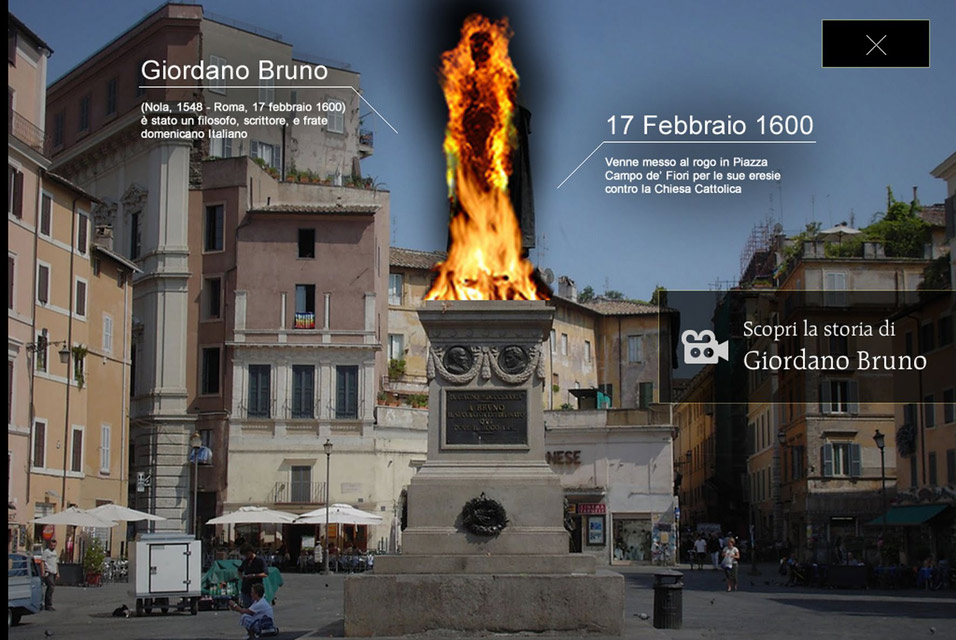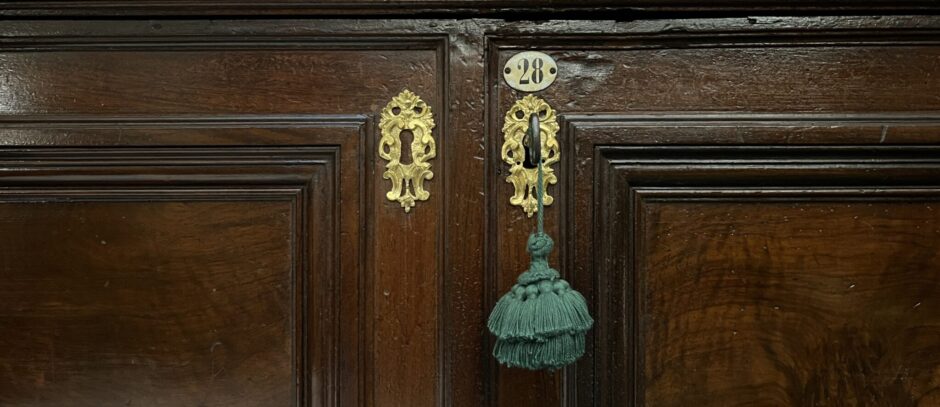I almost forgot! Today, 17 February, is the anniversary of Giordano Bruno’s meeting with the stake in the Campo de’ Fiori of Rome. Anti-Catholics and masons put up a gloomy, ugly huge statue of him, the base decorated with plaques of famous heretics and Church haters.
Giordano Bruno was a seriously weird cat and a heretic. He would find himself right at Villanova or the Fishwrap (aka National Schismatic Reporter).
A few years ago, The History Blog had a longish piece about the heretic. It included a screen shot of a smart phone app which would let you burn Giordano at the stake. Here is a shot:

Okay, it’s a little grisly. But think about it. Heresy is a serious matter.
The moral of the story: don’t be a heretic!
On that note, please consider buying some well-roasted …
When your’re facing a hard day battling theological error and the miscreants who teach it, start out with a blazing hot Fr. Z swag mug of MYSTIC MONK Coffee! It’s just what you need to get fired up to face that To Do List. I like the dark roast.
The Wyoming Carmelites offer Mystic Monk TEA as well, if tea is your thing. They also have lots of gear.
MYSTIC MONK COFFEE!
It’s swell!


































You must be kidding are you advocating the burning of people who are thought to be a heretic?
It seems to me that that’s the statue of a heretic. And a repulsive statue to boot.
The statue isn’t too bad Fr. I’m not a fan of the pedestal (like nearly everything from that era, it’s disrespectful of the style of Rome), but the statue is sort of cool looking. Let me put it this way, compare this statue to that piece of steel they put in front of Termini to “honour” St JPII…now that is an ugly statue and a crime. I would gladly burn/melt that statue out of love and devotion for St JPII. I find it painful that the eternal city gives prettier statues to a weird freaky guy like Bruno than to a magnificent Saint like JPII.
If heretics were burned at the stake now, we’d be warm from the glow all winter long.
Giordano Bruno, IMHO, amply deserved his fate, as cardinal Giovanni Mercati also stated in 1942. In Early Modern Europe, they didn’t burn you just for being a heretic; you had to compound your case with a host of aggravating factors, and it seems that Bruno’s life purpose was to make that list as long as humanly possible. Not only did he abandon the religious life, he dabbled in magic and satanism, and, as John Bossy cogently argued (Bossy, John (1991). Giordano Bruno and the Embassy Affair. New Haven: Yale University Press), he was in all probability a spy for Elizabeth I who helped track down and execute numerous recusant priests in England. His arrogant demeanor and his seemingly superhuman ability to antagonize people wherever he went didn’t help, either.
I like to point Dawkins fans and the like to posts such as this one, by an atheist who is mortally embarrassed that a kook like Bruno should be made into a poster child by his movement:
http://armariummagnus.blogspot.com/2014/03/cartoons-and-fables-how-cosmos-got.html
[Spy for Elizabeth. I had forgotten that point.]
Here in the JonPatrick household we only brew Mystic Monk coffee. There is nothing else like it. In fact I find it hard to drink ordinary coffee in restaurants anymore, it now tastes like dishwater. God bless the Wyoming Carmelites.
But think about the children, and Gaia and the planet and that HUGE carbon footprint! Oh the humanity! Oh Global Warming!
Even the BBC website says Lizzie executed as many Catholics as Mary did heretics:
https://www.bbc.co.uk/bitesize/guides/zrpcwmn/revision/6
Ok, she didn’t burn ’em but hanging, drawing and quartering, being the punishment for traitors, wasn’t much of an alternative. For the condemned.
I guess I have thought that the pain of any person or animal is something to engage with delight. But then again you added to it with the pun about coffee – Lot of class Father to bad it was all of the sec0nd class variety.
dmflinn: Of course, burning at the stake shocks the modern conscience. That was not Father’s point. He was commenting on (and debunking) an anniversary observed by modern seculars who have a distorted idea about Giordano Bruno as some kind of martyr to science, instead of a nutjob heretic and spy who was likely complicit in the deaths of real martyrs in Bloody Queen Bess’s England.
Many of the scientific ideas wrongly credited to Bruno, instead came from Nicholas of Cusa, who was not only not a heretic but a Cardinal, whose views were carefully stated and approved by Church authority (as described in the excellent link supplied by Fr Charles).
Fr Charles’ comments above are very important. Too often figures like Jordano Bruno or the Albigensians in the 13th century have been portrayed as little else than people who have a minor objection to just one line in the Credo. In fact, there were strange behaviors that were involved.
The same was true for seminaries. It wasn’t just a matter of vernacular liturgy with guitars and tambourines. There were also disgusting things happening.
Informative post and comments.
Giordano Bruno was also a pantheist, a Kabbalist, and a Hermeticist who attempted to restore the ancient Egyptian religion as recorded in the Hermetica (2nd century AD “wisdom texts”). Bruno’s name is well known and honored today (as a “martyr for science by the Papists”) among alchemists (yep, there are a few around today) and occultists- particularly the Rosicrucianists and the Hermeticists.
Jews and others also had the death penalty for heresy and sorcery (e.g. see “The Cabala of Pegasus” by Giordano Bruno) but also see the comment above by Fr. Charles A.F.. Bruno was given numerous opportunities to repent not only of his writings but his malevolent behavior (if I recall he was even restored once to his teaching position).
By contrast, a related topic:
Fr. Athanasius Kircher (1602-80), among his many accomplishments such as debunking alchemy (which even Isaac Newton worked at), also worked on deciphering hieroglyphics. Fr. Kircher grasped the phonetic value of hieroglyphs and the relationship between Demotic and the Coptic language. (Ancient Hieroglyphs led to Hieratic (“cursive hieroglyphs”) which led to Demotic a few centuries before Christ).
Fr. Kircher can be reasonably viewed as the Father of Egyptology, but it should be noted that his efforts to go beyond phonetic values and translate hieroglyphs were unsuccessful. Two centuries later Champollion relied on Fr. Kircher’s insight and the Rosetta Stone (which contained the same message written in three languages: Greek, Demotic and Hieroglyphs) to finally translate Hieroglyphs.
robtbrown makes an excellent point about the Albigensians and their “strange behavior.”
The Albigensians were a death cult in 13th-century southern France. Its roots were in Arianism, Manicheanism, the violent Bogomils and the Cathars. The Albigensians believed God’s creation and creatures, including humans, were evil- they were hostile to marriage and children, and were pro-abortion and pro-suicide (starvation was preferred). Thus, the Albigensians could expand only by converting others.
The feudal lords in southern France mostly supported Albigensianism- the cult was a way to increase their power and money against the restraints of the Church and the French King of the developing French state.
For a few years Pope Innocent III and the local Catholic archbishop did not resort to a Crusade against the death cult- they worked on a revival of the Christian faith in southern France. Then, after a Papal delagation to the Albigensians was massacred in 1208 a Crusade was declared.
It is almost certainly accurate that some of the Crusaders were too zealous in conquering the death cult and their feudal lord protectors. It is probably untrue that the Crusaders marched under the banner of “Kill them All, God will know His own.”
To tone things down in the future, Gregory IX and the Dominicans set aside the Crusade for the Inquisition.
Gumby,
Good stuff. I would add Gnosticism, whose serpent’s head appears in various guises (cf your notes above) and various times, including our own.
robtbrown: You bet, Gnosticism too, back then and today.